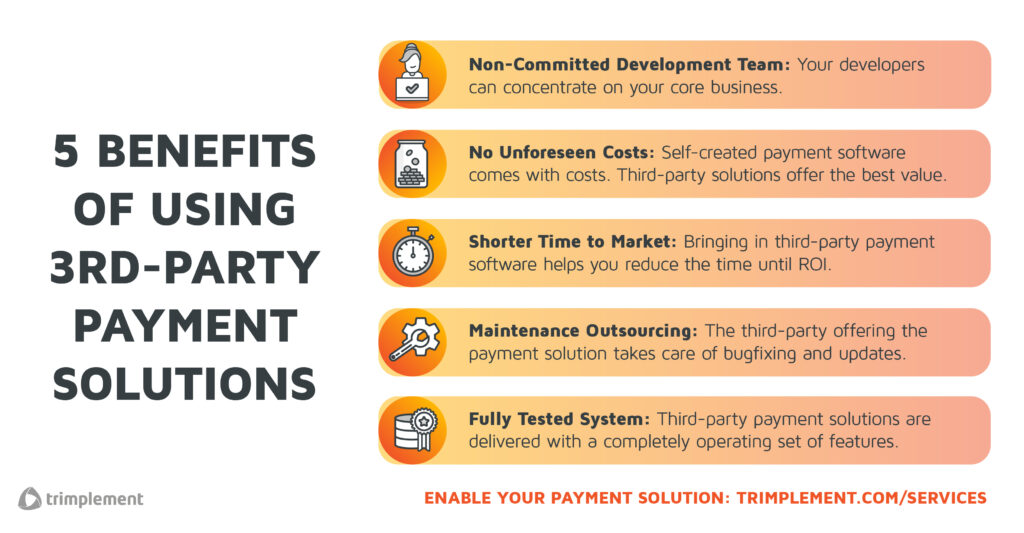Do it yourself—it’s an overrated mantra.
At first, those three letters promise empowerment. You have full control over what you do and which way you want it to be done. Take fice, third-party software, we are on it ourselves.
But then you stumble over the prerequisites. You have to know how to do it all in the first place. And that you have the right tools for the task. But that should be doable, too. I have a screwdriver lying around somewhere! And there must be a YouTube tutorial for this, right?
Well, when it comes to the complex field of software development, the truth is a little more complicated.
The Advantages of Using Third-Party Software
DIY doesn’t necessarily bring A-okay results. In fact, there is a wide range of factors, which should be considered by companies, before deciding to develop their product from scratch. If you’re asking yourself “Why to use third-party software instead of self-developed products”, you should mind the 5 advantages of the former approach:

1. Your Workforce Is Where You Need It
You won’t develop any software product without an experienced development team. If specific features don’t belong to your key business, you still have to commit parts of your software engineering workforce to create them. This means they are no longer accessible when you want to change or expand your core product—unless you have the budget or spatial capacity to enlarge your developer team.
By bringing in external software products (and developer teams, who integrate them into your infrastructure) allows you to keep your own workforce focussed on the heart of your product.
2. You Can Put Your Money Where Your Business Is
Assign your developers to establish new software from the ground up is a cost factor to reckon with. At least as far as you can reckon it: Unforeseen costs can manifest when problems and bottlenecks pop up during the development process.
Buying third-party software is often a more cost-effective way. You know that the sum you pay will yield you the results you want. Additionally, taking all hidden costs into account, third-party software often provides the best value for the money spent.
3. You Get Your Product Ready in Short Time to Market
Aside from budget and workforce, developing software depletes an even more valuable resource: time. You don’t only have to calculate the time investments of the actual development process. You have to take in time for meetings, feature design sessions and probably research to learn the ropes of a specific field in the first place—not to mention the time required for project planning itself. In the meantime, the market moves and your competitors might already be a few steps ahead of you.
So, using third-party software is a way to accelerate the development process and hit the right point in time to release your product.
4. You Reduce Complexity for Your Team
Developing a certain feature in-house means that your team has to have expert knowledge about all of its nuts, bolts, and functionalities. That means, your developers will have to grind through working hours spent in knowledge transfer or consulting sessions. In addition, the more of the code your software team produces, the more they have to have to oversee, integrate and keep in a working state, too. While creating new features might be done quickly, bug-fixing and maintenance are often more time-consuming.
The third-party software provider’s team already knows the software by heart. They are the experts, you can turn to when having in-depth questions regarding functionality and code. Your own team does not have to remember it all.
5. You Get A Finished, Battle-Proven Product
Developing new software products is rife with drawbacks and complexities. Grasping new business domains and probably technologies, working with changing product requirements, correcting errors—it all takes a huge amount of effort during the development process. And how software behaves on the test system and how it behaves in productional environments, that’s two different stories.
With third-party software, you can rest assured in most cases, that it scales and performs well. The software has circled through its fair share of bug-fixing rounds and tests. At best, it also has been used in live products, so it won’t suddenly give up on its promises, once it’s in use. A new piece of software, on the other hand, still has to prove itself on a live system.
But Will I Still Be Flexible?
When considering why to use third-party software, there is one argument, which is not easily invalidated: The need for flexibility in software products. It’s understandable, you don’t want to use a third-party product, as you deem it too static and not unadaptable to the unique vision of your business. If you can’t control it, you rather do it yourself.
Don’t jump lightly to such a conclusion. Not all third-party software products are “off-the-rack” solutions that cannot be changed. In the software business, it’s actually common to base one’s own work on the work of others—we don’t conceive a new programming language for every application we aim to create.
What you should look after are frameworks, APIs or white label products with source code access instead of finished, hermetical products off-the-rack. These might require a little more work on your side, as they only provide the coded shell construction, to which you have to add the walls and roofs, so to speak.
The good thing is: The tricky parts have already been done, but you still have enough room to create the products that match your vision.
There are many reasons why using third-party software has advantages over building everything from the very ground in-house. Don’t choose the DIY way under false impressions. Introducing specialized frameworks by external developers saves time, money and effort.
You don’t have to reinvent the wheel when someone else can take you along for a ride. You will still reach the destination you want to go with your business.
The Best of Both Worlds – Finergizer
At trimplement, we specialize in building custom-tailored online payment solutions for different industries. We look back on many years of experience in payment software development for big e-commerce players and financial institutions.
Finergizer is our cutting-edge on-premise payment orchestration solution. It’s scalable, reliable and easily adaptable to your needs. The RESTful API also makes it easy to integrate Finergizer in your existing infrastructure.
Learn more about the platform on the Finergizer product page.

